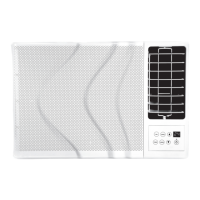PGD4, PGS4, Series G, H WPG4 Series D, H Ultra Low NOx: Installation Instructions
Manufacturer reserves the right to change, at any time, specifications and designs without notice and without obligations.
17
If larger adjustments are required, change main burner orifices following
the recommendations of national and local codes.
NOTE: All other appliances that use the same meter must be turned off
when gas flow is measured at the meter.
Proceed as follows:
1. Turn off gas supply to unit.
2. Manifold pressure connections
a. For standard gas valves, remove manifold pressure tap cover
using an allen wrench. (See Fig. 15). Install barbed pressure tap
and hose to connect to manometer. Turn on gas supply to unit.
b. For gas valve with tower pressure ports, loosen set screw on
manifold tower pressure tap no more than one full turn with a
3/32-in. hex wrench. (See Fig. 16.) Connect manometer by
sliding 5/16” connecting hose over the manifold tower pressure
port. Turn on gas supply to unit.
3. Record number of seconds for gas meter test dial to make one
revolution.
4. Divide number of seconds in Step 3 into 3600 (number of seconds
in one hr).
5. Multiply result of Step 4 by the number of cubic feet (cu ft) shown
for one revolution of test dial to obtain cubic feet (cu ft) of gas flow
per hour.
6. Multiply result of Step 5 by Btu heating value of gas to obtain total
measured input in Btuh. Compare this value with heating input
shown in Table 5 (Consult the local gas supplier if the heating value
of gas is not known).
EXAMPLE: Assume that the size of test dial is 1 cu ft, one revolution
takes 32 sec, and the heating value of the gas is 1050 Btu/ft3. Proceed as
follows:
1. 41 sec. to complete one revolution
2. 3600 / 41 = 87.8
3. 87.8 x 1 = 87.8 ft
3
of gas flow/hr
4. 87.8 x 1050 = 92,190 Btuh input
If the desired gas input is 89,000 Btuh, only a minor change in the
manifold pressure is required.
Observe manifold pressure and proceed as follows to adjust gas input:
1. Remove regulator cover screw over plastic adjustment screw on gas
valve (See Fig. 15 and Fig. 16).
2. Turn plastic adjustment screw clockwise to increase gas input, or
turn plastic adjustment screw counterclockwise to decrease input
(See Fig. 15 and Fig. 16). Manifold pressure must be between 3.2
and 3.8 IN. WC.
NOTE: Manifold pressure must be checked with the access door on.
3. Replace regulator cover screw on gas valve (See Fig. 15 and
Fig. 16).
4. Turn off gas supply to unit.
5. Removing manometer from pressure tab.
a. For standard gas valve, remove manometer hose and barbed
pressure tap. Replace pressure tap cover using an allen wrench.
(See Fig. 15.)
b. For gas valve with tower pressure port, remove connecting hose.
Tighten set screw on manifold pressure port using a 3/32” hex
wrench. (See Fig. 16.)
6. Turn on gas to unit and check for leaks.
WARNING
!
FIRE AND UNIT DAMAGE HAZARD
Failure to follow this warning could result in personal injury or death
and/or property damage.
Unsafe operation of the unit may result if manifold pressure is outside
this range.
Table 4 – High Altitude Compensation, Natural Gas - Single and Three Phase Models
Nameplate Input (Btu/hr)
Rated Heating Input (Btu/hr), Natural Gas at Installation Altitude Above Sea
Level, U.S.A.
*
*. In the U.S.A., the input rating for altitudes above 2000 ft (610m) must be reduced by 4% for each 1000 ft (305 m) above sea level.
In Canada, the input rating for altitudes from 2001 to 4500 ft (611 to 1372 m) above sea level must be derated by 10% by an authorized gas conversion station or dealer.
For Canadian Installations from 2000 to 4500 ft (610-1372 m), use U.S.A. column 2001 to 3000 ft (611 to 914 m).
0 to 2000 ft
†
(0-610 m)
†. Altitude of 2001 and above is not allowed.
45,000 45,000
60,000 60,000
89,000 89,000
Table 5 – Heating Inputs
Heating Input
(BTUH)
Number of Orifices
Gas Supply Pressure (IN. W.C.)
Manifold Pressure (IN. W.C.)
Natural
†
Propane
*†
*. When a unit is converted to propane, different size orifices must be used. See separate, natural-to-propane conversion kit instructions.
†. Based on altitudes from sea level to 2000 ft (610 m) above sea level. In U.S.A. for altitudes above 2000 ft (610 m), reduce input rating 4 percent for each additional 1000 ft (305
m) above sea level. In Canada, from 2000 ft (610 m) above sea level to 4500 ft (1372 m) above sea level, derate the unit 10 percent.
N/A = Not applicable (Units are not convertible to propane)
Min Max Min Max Natural
†
Propane
*†
45,000 1 5 13.0 N/A N/A 3.2~3.8 N/A
60,000 1 4.5 13.0 N/A N/A 3.2~3.8 N/A
89,000 1 5 13.0 N/A N/A 3.2~3.8 N/A

